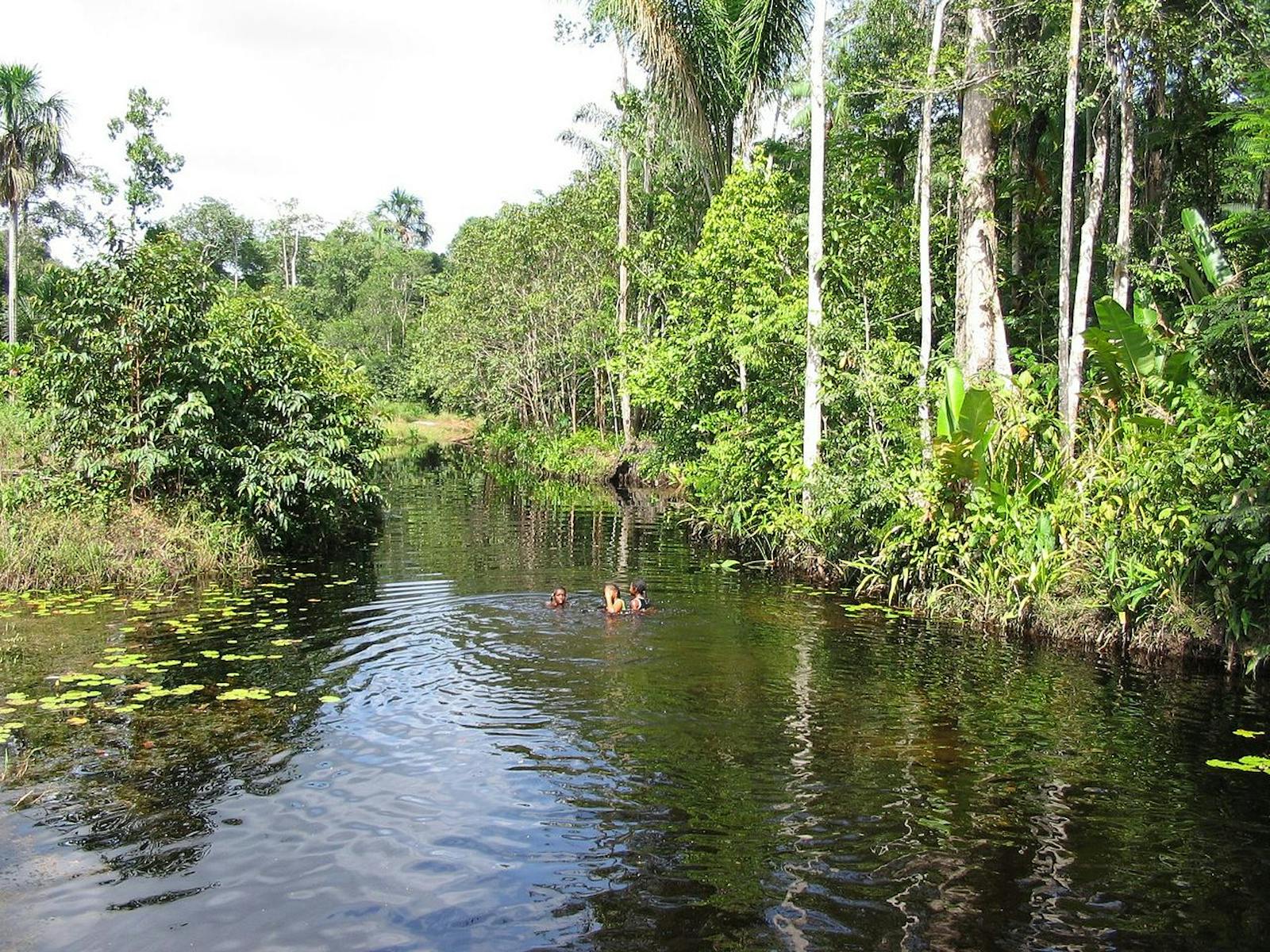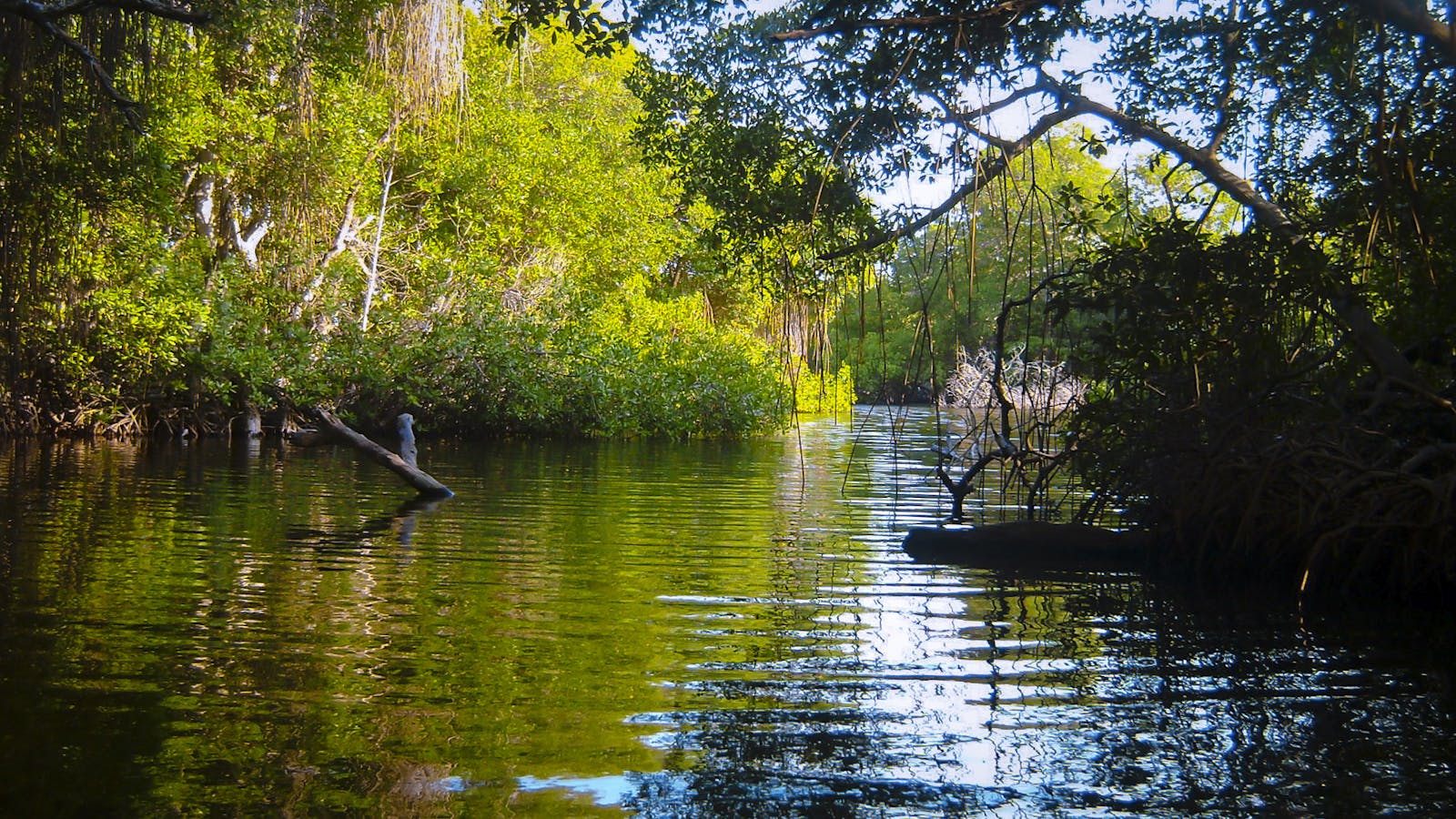Guianan Freshwater Swamp Forests
The ecoregion’s land area is provided in units of 1,000 hectares. The conservation target is the Global Safety Net (GSN1) area for the given ecoregion. The protection level indicates the percentage of the GSN goal that is currently protected on a scale of 0-10. N/A means data is not available at this time.
Bioregion: Guianan Forests & Savanna (NT21)
Realm: Southern America
Ecoregion Size (1000 ha):
774
Ecoregion ID:
463
Conservation Target:
75%
Protection Level:
1
States: Suriname
The brilliant-thighed poison frog is found in lowland moist forests and wetland areas throughout central South America, including the Guianan Freshwater Swamp Forests. It lays its eggs on leaf litter and will carry tadpoles on their backs to temporary pools. This allows them to carefully select a home for each tadpole in different puddles, bromeliads, or tree trunks. This small “poison dark” frog is aptly named for its bright orange or yellow patches at the thigh and shoulder, on an otherwise dark body with a white line down both sides. These little frogs are has evolved defensive mechanisms against predations with their toxin-secreting skin, which predators quickly learnt to avoid. They are active by day looking for small insects in the leaf litter, and at night hunkering down and hiding under leaves, branches, or debris.
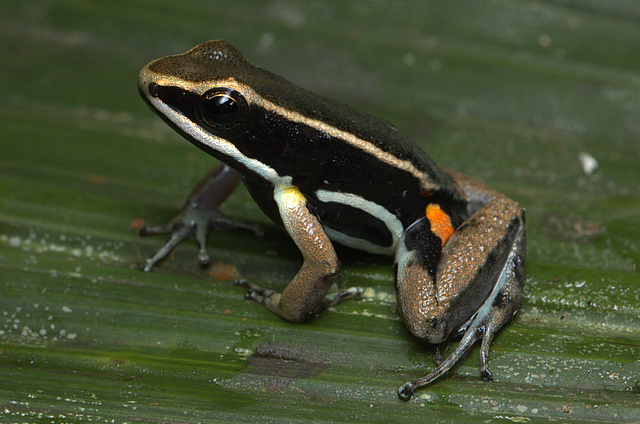
The flagship species of the Guianan Freshwater Swamp Forests ecoregion is the brilliant-thighed poison frog. Image credit: Creative Commons
This Swamp Forests ecoregion extends as a narrow, near-coastal strip across all of northern Suriname, from the Courantyne River along the Guyanan border to the Maroni River along the French Guianan border. The ground is mostly covered in a layer of peat which can supress the growth of some trees and make the swamp forests short in stature. These forests occur within a matrix of other forest types and are convergent with mangroves to the north along the coast, and terra firma moist forests on all other sides.
Climate in this region is hot and wet with two rainy seasons (Dec-Jan and May-Aug) with short dry spells in between. Two rainy and two dry seasons can be distinguished. The soil here swells during an almost permanent flooded period and shrinks during dry seasons, and is covered with a peat layer.
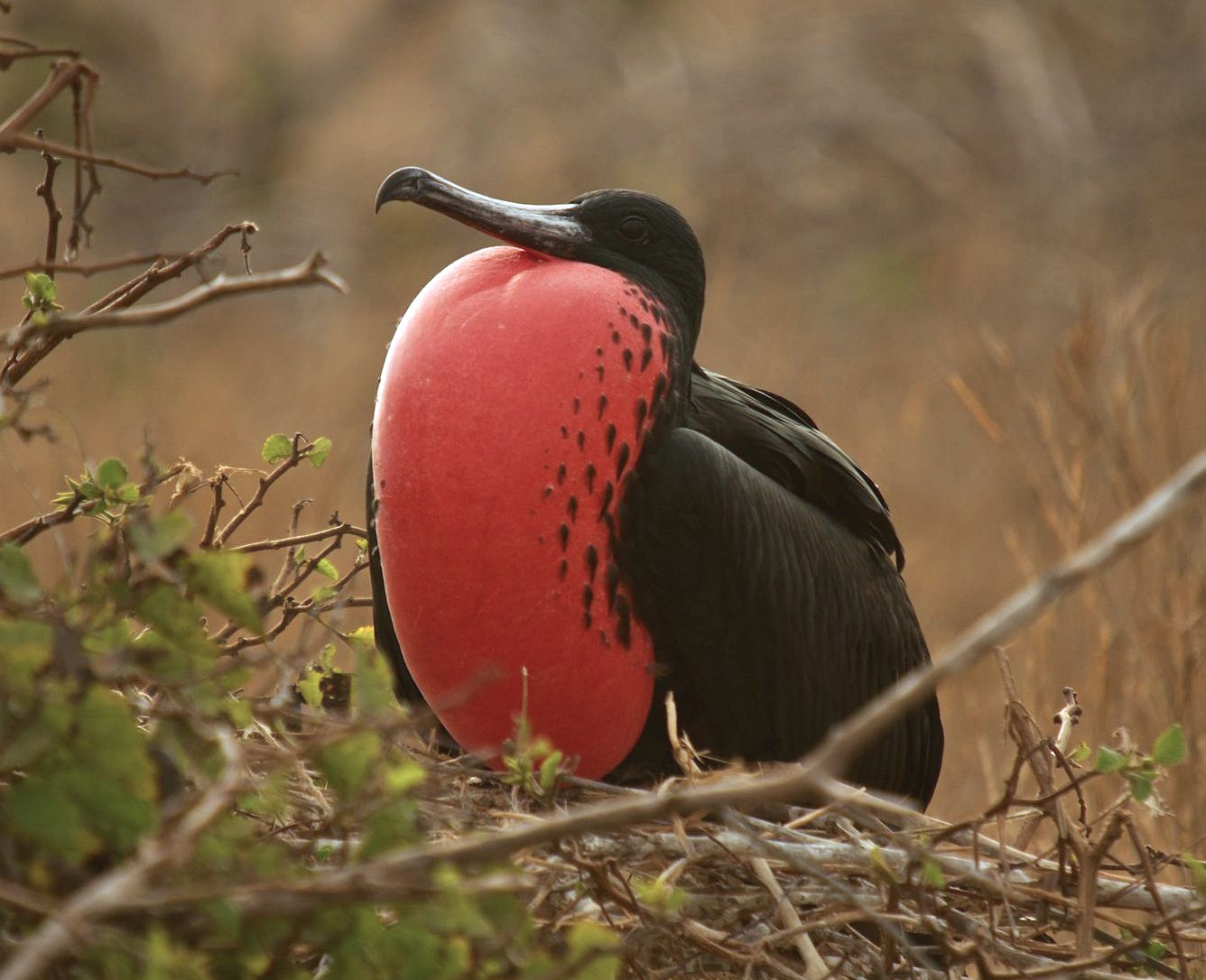
Magnificent frigate bird. Image credit: Andrew Turner, Creative Commons
Floristically, these tropical, moisture tolerant, swamp forests are part of the Guyana lowland floristic province and support a diversity of vegetation types from freshwater swamp forests, swamp wood, swamp scrub to herbaceous swamps. Peat fires and water depth are often limiting factors to the predominant vegetation cover. In the absence of peat fires, swamp forest in shallower water show the highest plant diversity. In the shallower freshwater swamps in the northern Coastal Plain, characteristic tree species for the final climax stage of swamp forest vegetation include the baboonwood, chewstick, and the açaí palm.
Further south, where swamp depth during rainy season may exceed 3.5 m, the area becomes floristically poor in species. In this southern area, the final climax stage of swamp forest vegetation is characterized by the legume tree species, and the Maraja palm. Swamp wood in shallower waters is often dominated by one or only a few species of trees. Similarly, herbaceous and scrub swamps are often dominated by one or only a few species of plants.
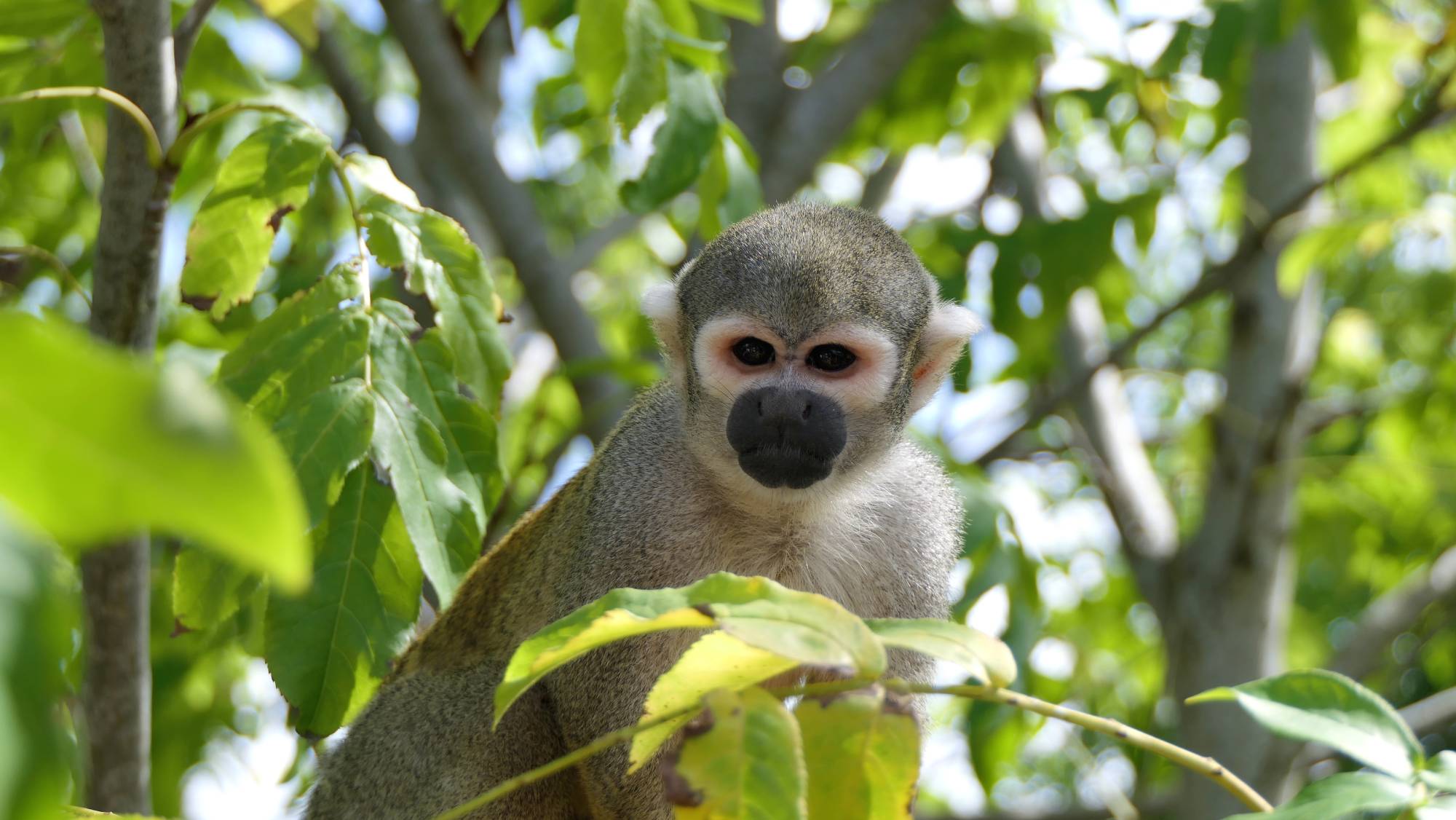
Squirrel monkey. Image credit: Creative Commons
Mammals in this ecoregion are relatively diverse with high species richness, but many of the species are shared with neighbouring Amazonian forests and mangroves (giant otter), thus endemism is low. Notable are the diversity of primates, of which five are using these swamp forests annually or are permanent residents. These include: Midas tamarin, South American squirrel monkey, Guianan saki, brown capuchin, and red howler monkey. Internationally, the coastal plain of Suriname is a very important for breeding, passage, and wintering waterfowl such as scarlet ibis and semipalmated sandpiper. No endemic birds are known from this ecoregion. Reptiles and amphibians include species that can either get off the ground or cope with seasonal flooding, including arboreal species like iguanas and anoles as well as a variety of frogs and toads.
-2018.jpg)
Carvalho's slider. Image credit: Bernard Dupont, Creative Commons
Several protected areas (including Wia Wia, Peruvia, Boven Coesewijne, Copi, and Wane Kreek Nature Reserves) are within or partially within the boundaries of this swamp forest ecoregion, which offer varying degrees of protection and representation. Because of the inhospitable nature of these swamp forests, large tracts remain relatively undisturbed and inaccessible. However, the network of rivers and streams, canals, sand ridges, roads, and plantation dykes permits the extraction of timber, and flora and fauna for the pet trade in some easier to access areas.
Additional threats to this ecoregion are diverse and include human-caused grass and peat fires, draining swamps for urban and rural development, rice cultivation and dry crop agriculture, oil field development, damming up of swamp areas for storage of irrigation water, discharge of agrochemicals, introduction of exotic plants, construction of roads and transport canals, swamp forest exploitation, and drainage and channelizing for logging, bauxite mining, and industry. Because of the strong riparian influences of this ecoregion, it is affected to some degree by almost all upstream pollution and runoff.
The priority conservation actions for the next decade are to: 1) limit logging practices to more common species and encourage replanting; 2) end draining of the swamps for development; and 3) manage upstream water contamination.
Citations
1. Schipper, J., P. Teunissen. 2018. Northern South America: Northern Suriname, into eastern Guyana and French Guiana. https://www.worldwildlife.org/ecoregions/nt0149. Accessed July 30, 2018.
2. Teunissen, P.A. 1993. Vegetation types and vegetation succession of the freshwater wetlands. In P.E. Ouboter (editor), The freshwater ecosystems of Suriname. Kluwer Academic Publishers, Dordrecht. 313 pp.
3. Eisenberg, J. 1989. Mammals of the Neotropics Volume 1: the northern Neotropics. University of Chicago Press, Chicago.
4. Enrique La Marca, Claudia Azevedo-Ramos, Robert Reynolds, Luis A. Coloma, Santiago Ron 2010. Allobates femoralis. The IUCN Red List of Threatened Species 2010: e.T55038A11244330. Accessed June 28, 2019.
